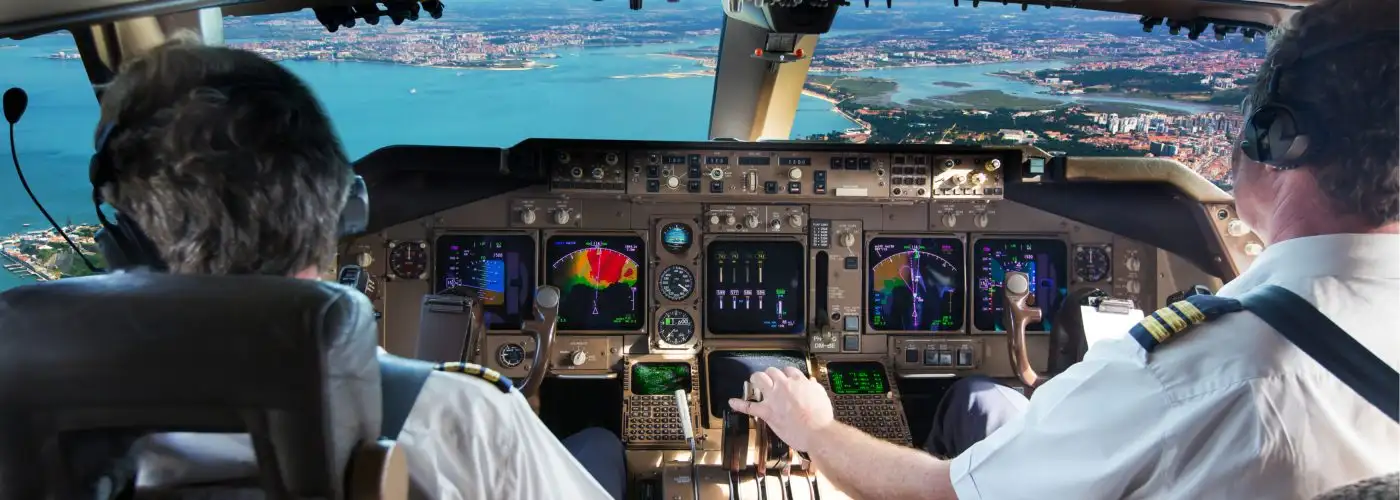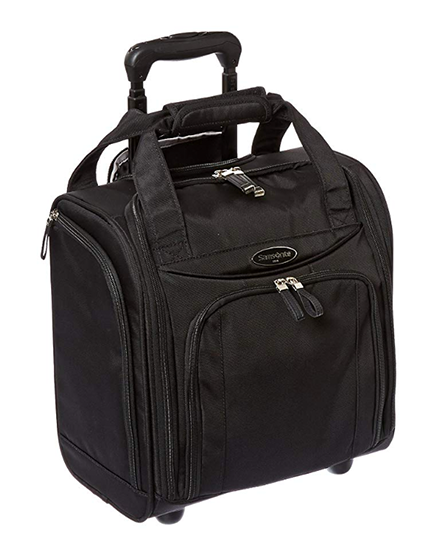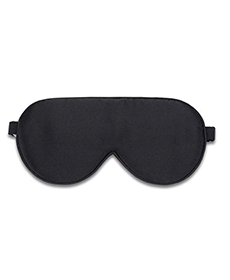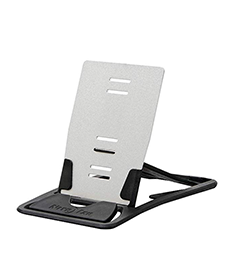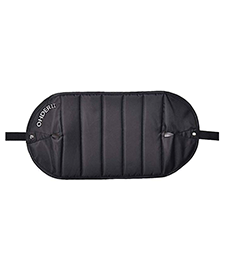When we contacted author, columnist, and pilot Patrick Smith to ask what he and fellow pilots could tell us about flying that we might not know, he responded with an emphatic “Where do I begin?”
Indeed, Smith has been writing columns, blogs, and books on this very topic for the past 14 years, including a New York Times bestseller called “Cockpit Confidential.” On his website, AskthePilot.com, you can browse his FAQ section to get answers to common questions about air travel.
“When people would start a question about flying [with] ‘Is it true that…’ the answer was almost always ‘No, that is completely untrue!'” Smith told us. “That was why I started writing about flying.”
Smith, a long-haul pilot for a major carrier that he prefers not to disclose, took his first flying lesson before he could drive at the age of 14 and began flying for a commercial airline in 1990. We asked him about misconceptions about flying, what it’s like to see the world from 35,000 feet, and what he has in common with the rest of us.
The Plane Flies Itself, Right? Not Really
One of Smith’s biggest pet peeves is a mistaken belief that even seasoned travelers seem hard-pressed to shake: that when a plane is on “autopilot” it is flying itself, like some gargantuan Google Car of the skies.
“I’m not sure where the idea comes from,” Smith said with a hint of exasperation. “It might be that pilots are our own worst enemies in this regard, as a lot of pilots are very enamored of the technology we use, and might say something like ‘we press these buttons and the plane flies itself.’ And in one sense that is true, but people take it very literally.”
One of the most common statements I hear is that not only do the planes fly themselves, but they also land themselves, which Smith denied emphatically, noting that nearly all of the landings he participates in are almost entirely manual.
“There is such a thing as an automatic landing, but I see maybe a couple per year,” he said. “Even with all the automation up and running, you are still always flying the plane. You are not necessarily steering with your hands on the wheel for the entire flight, but the automation only does what you tell it to do, and you have to tell it what to do, when to do it, how to do it, where to do it. The way I describe it is that there are probably six or seven different ways I can command a climb or descent using the automation, depending on the circumstances. The pilot has to determine all of that, and then execute it, make necessary changes, etc.”
Smith once flew a cargo plane across the Atlantic with the autopilot “deferred—which means it wasn’t working,” he explained. “It was simple to deal with, but there is a certain challenge to having your hands on the yoke of a plane for eight hours.”
I asked how hard this was, and whether the pilot had to wrestle with the plane the whole way, which Smith said depended on conditions. In a case like that, the plane could “fly itself” for short periods, perhaps in the way a boat can do the same if you point it in the right direction—but not for much more than that, particularly since you have to worry “not only about left and right, but up and down,” said Smith.
“Autopilot was invented to relieve pilots [from] physically [being] on the wheel, or the yoke, for the entire flight,” Smith said. “It doesn’t take the pilot out of the loop, but does make certain tasks easier.”
Turbulence Is Normal
“When I first started writing and taking questions about flying, I was really startled by the number of people who are made anxious by rough air, because from our perspective it’s normal,” Smith said. “Not to be dismissive or too nonchalant about it, as it is true that every year a certain number of people are injured in encounters with turbulence. But typically it is because they weren’t seatbelted in when they should have been.”
So Smith is not spooked at all by what I sometimes think of as “potholes in the sky,” but when pressed to think about what does spook a pilot, he did have some concerns about how air turbulence is changing.
“It’s becoming more evident that climate change is increasing the number of encounters with unusually strong turbulence,” he noted. “It stands to reason that if certain climatic patterns are exacerbated, there are going to be a lot of things that come together to make for a bumpier atmosphere.”
Do Pilots Get Bored up There?
“Every professional in every line of work at some point becomes a bit bored, but boredom is not the right word,” Smith said. “Am I sometimes bored over the middle of the ocean at night when not a lot is going on? Sure, but I could bet you can find a surgeon who would say he gets bored in the middle of brain surgery. It’s all relative, so what I like to do in those moments is reflect back on how I got to where I am professionally. When I was a little kid reading airline timetables and imagining what it would be like to be a pilot, now to actually doing it, it keeps me grounded, to use a bad pun.”
Window or Aisle?
“Somebody with an enthusiasm or vested interest in flying is always going to take the window seat, because they enjoy having that constant reminder that you are in this remarkable machine in the air. Over the years you see so many cool things from the air, it is hard to know where to start. Flying over the Sahara Desert, seeing the icebergs in the north Atlantic, flying over the city of Istanbul, looking down at the pyramids, flying over the American West, seeing the northern lights…”
Smith’s book includes a list of the best things he has seen from the air, underlining his continued enthusiasm for seeing the planet from on high. But he also noted that pilots have a unique perspective on some of the more distressing landscapes on the planet, including disappearing rain forests, clearcutting fires and smog over major cities.
“Being able to look down for so long at so much of the planet, what I take away from it is how small the Earth really is, almost in a scary way that might serve as a warning,” Smith said. “A lot of the damage we are doing to the world is very visible from an aircraft.”
Pilots Are Easygoing Passengers
When we see pilots take empty seats on a plane, we might wonder if they are judging everything that is going on, if they’re worried, if they’re ticked they are stuck in coach. What’s it like for a pilot flying as a passenger?
“It’s like flying as a passenger,” Smith said with a laugh. “We don’t really do any backseat piloting; we’re so familiar with the training that goes into being a pilot that it is hard to get nervous.”
But it’s not all good times: “The things that annoy me about flying are the same things that annoy the average passenger.”
Pilots Are Almost as Unimpressed by Airport Security as You Are
Which brings us to airport security: “The system we have come up with is in some ways so irrational that it makes me question our collective sanity,” Smith said. “Some of it is good and works well, but enough of it is so irrational and unreasonable that it is distressing.
“The parts that work are the parts that we don’t see; the stuff that goes on offstage, so to speak. That really is the nuts and bolts of airport security. What we have on the concourse is another story. I’m not saying that onsite airport security is a bad idea; of course it’s not. But the specifics of what we have come up with are head-scratching. And that would be excusable if they didn’t waste such immense amounts of time and money. Security has now become the single most tedious and aggravating part of flying, and it doesn’t have to be that way.”
For pilots, “There is a certain rolling of the eyes and grumbling, but in the end we acquiesce. I think there should be more pushback against rules that are obviously a waste of time and money; why airline employees and airlines haven’t come together to ask for change, I don’t know.”
Smith writes at length about the state of airport security here in Terminal Madness: What Is Airport Security?; it’s well worth a read.
You Can Glide a Plane Home
In the aftermath of the famous successful water landing of US Airways Flight 1549, which lost both engines after colliding with a flock of geese and ended up in the Hudson River with no serious injuries, many people wondered if you could do that with any plane under any circumstances.
“Even the biggest plane glides perfectly well,” Smith explained. “In fact, the glide ratio—the altitude lost to the distance covered—is actually better in some bigger airplanes than in very small airplanes.
“But most people don’t realize that as a passenger, you glide all the time,” he said. “Descents are often made at what we call ‘idle thrust,’ which means that the engines are still running, but they are producing no forward power or thrust. They are powering the electricity and the air and everything, but they are doing nothing otherwise; you are gliding. If the engines were shut off completely at that point, it would be dark, and none of the internal systems would be powered, but the plane wouldn’t be gliding any differently.
“And that happens on pretty much every flight; there is always some point where you are at idle thrust.”
So instead of saying have a nice flight, perhaps we should say have a nice glide.
What to Buy Before You Fly
More from SmarterTravel
- 10 Things Not to Do When Checking a Bag
- Can a Flight Attendant Force You to Close the Window Shade?
- 9 Must-Dos Before a Long-Haul Flight
We hand-pick everything we recommend and select items through testing and reviews. Some products are sent to us free of charge with no incentive to offer a favorable review. We offer our unbiased opinions and do not accept compensation to review products. All items are in stock and prices are accurate at the time of publication. If you buy something through our links, we may earn a commission.
Related
Top Fares From
Today's Top Travel Deals
Brought to you by ShermansTravel
France: 8-Night Paris, Avignon & Nice...
Infinity Worldwide Vacations
 vacation
$2880+
vacation
$2880+
Poconos: 3 Nts in Garden of...
ResortsAndLodges.com
 hotel
$305+
hotel
$305+
7-Nt Canada & New England Cruise,...
Princess Cruises
 cruise
$839+
cruise
$839+
